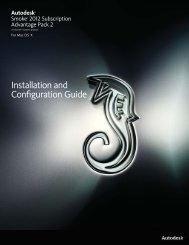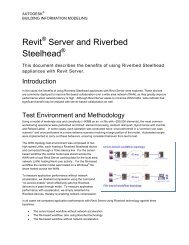Installation and Configuration Guide for Linux® Workstations
Installation and Configuration Guide for Linux® Workstations
Installation and Configuration Guide for Linux® Workstations
You also want an ePaper? Increase the reach of your titles
YUMPU automatically turns print PDFs into web optimized ePapers that Google loves.
There are two kinds of Lustre workstations:<br />
■ The Master Station is designed <strong>for</strong> GPU-accelerated sessions where the colorist works together with the<br />
cinematographer. It includes a toolset <strong>for</strong> visual design <strong>and</strong> grading, using up to 4K resolution <strong>and</strong> 16-bit<br />
files <strong>and</strong> <strong>for</strong> completing tasks like dust busting, con<strong>for</strong>ming, rotoscoping, <strong>and</strong> capture/playout. It also<br />
includes SD <strong>and</strong> HD I/O, dual link <strong>and</strong> HSDL video <strong>for</strong>mats, <strong>and</strong> the film workflow features, which consist<br />
of infrared channel dust removal <strong>and</strong> support <strong>for</strong> all st<strong>and</strong>ard input <strong>and</strong> output resolutions <strong>and</strong> bit-depths.<br />
The Master Station can support up to three panels of the Autodesk Control Surface <strong>and</strong>, with an additional<br />
license, a Slave Renderer.<br />
■ The optional Lustre Station offers a way to improve the efficiency <strong>and</strong> cost-effectiveness of a pipeline by<br />
offloading tasks that do not require the full feature set of the Master Station. Multiple Lustre Stations<br />
can work in parallel to increase throughput <strong>and</strong> can be used <strong>for</strong> tasks such as dust-busting, preparatory<br />
work, fine-tuning creative sessions, con<strong>for</strong>ming data from EDLs, updating editorial changes, <strong>and</strong> mastering<br />
to different <strong>for</strong>mats using the real-time deliverables function. The Lustre Station includes the film workflow<br />
features, <strong>and</strong> the ability to create geometries <strong>and</strong> masks. Primary colour grading on the Lustre Station<br />
requires a separate license. The following features also require an additional license: SD <strong>and</strong> HD I/O, dual<br />
link <strong>and</strong> HSDL video <strong>for</strong>mats. The Lustre Station does not support the Slave Renderer.<br />
Optional Components<br />
Control Surface Provides improved interactivity when colour grading film <strong>and</strong> video footage. You can<br />
per<strong>for</strong>m many of the same tasks you do in the Lustre user interface using the Control Surface. You connect<br />
the Autodesk Control Surface to a Master Station <strong>and</strong> configure the Control Surface on the workstation to<br />
which it is connected.<br />
Video I/O Card <strong>and</strong> Breakout Box On the HP Z800 workstation, video I/O is provided by the AJA card.<br />
The video I/O card consists of an HD/SD card <strong>and</strong> a breakout box. This configuration provides real-time SDI<br />
input <strong>and</strong> output of uncompressed 8-bit or 10-bit HD or SD video in both YUV (4:2:2) <strong>and</strong> RGB <strong>for</strong>mats<br />
(4:4:4 or 4:2:2). For a list of supported video <strong>for</strong>mats, see the Autodesk Lustre User <strong>Guide</strong>. The drivers <strong>for</strong> the<br />
video card <strong>and</strong> breakout box are installed by the Discreet Kernel Utility (DKU).<br />
Slave Renderer The Slave Renderer frees system resources by automatically off-loading render tasks. Connect<br />
the Slave Renderer to a switch on your house network. Note that only one Lustre Master station can use the<br />
Slave Renderer. The Slave Renderer software package is installed on the Slave Renderer.<br />
Background Renderer Background rendering frees up Lustre workstations <strong>for</strong> colour grading. You can use<br />
up to eight background rendering machines to process your final frames. Background rendering software is<br />
installed on each background render node<br />
Typical <strong>Configuration</strong> Overview <strong>for</strong> Lustre | 7




